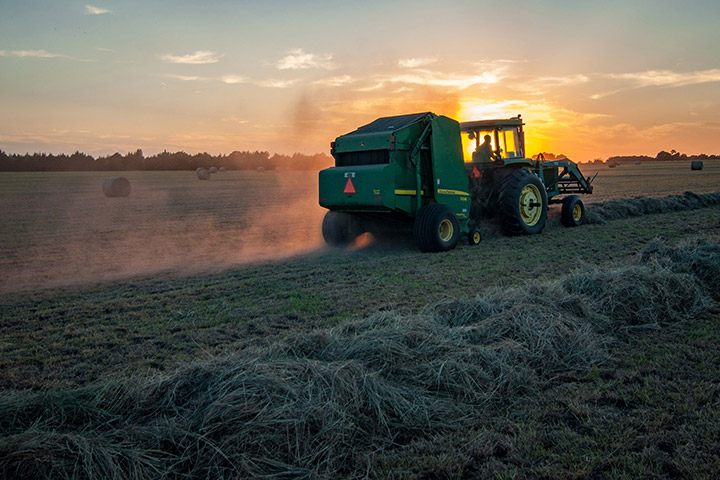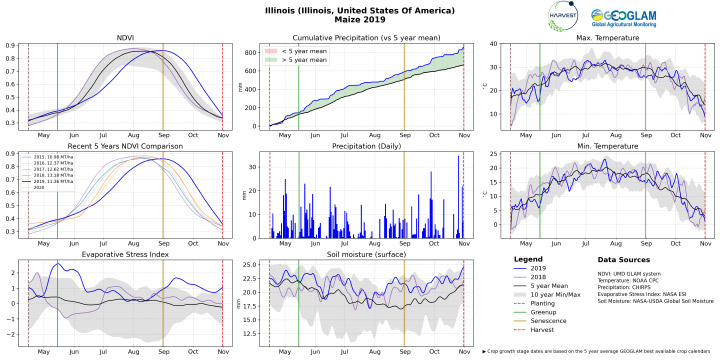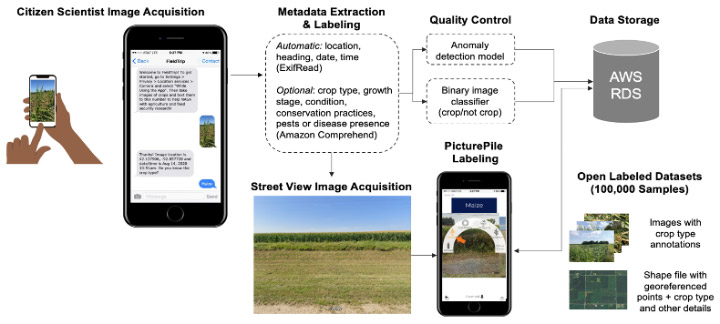

How Earth observation technologies are revolutionizing global agri-food systems.

Nowadays, various forms of technology play a fundamental role in our daily routines. From the use of GPS to navigate to different places, to sharing pictures using just our smartphones, to automatic vacuum cleaners, there are endless examples. Even when it comes to the food we eat there have been so many technological advances and an immeasurable amount of research developed, particularly in the past few decades.
But one common technological thread that we can find within all of these different aspects of our lives is Earth Observation Technologies (EOT) and remote sensing. Numerous Earth observing (EO) satellites have been launched into space by NASA and other international space agencies within the last decade, serving to collect (or “remotely sense”) data about our home planet, which helps experts around the world to better understand our ecosystems and environment. We’ll take a look at agricultural production, international food markets, and global food security as an example of the importance of this remotely sensed Earth observation data.
There are several steps and many factors involved from the time a crop is grown on a plot of land to the availability of certain crops and the price volatilities eventually seen in the corresponding food market system. Because of the complicated paths of the agricultural supply chain, it is often easier to understand this relationship if we think about it as a collective “agri-food system.” Over the past decades, agri-food systems have evolved in so many aspects, but so have the EO technologies that make it easier to understand and monitor every step of this complex chain, bringing transparency and efficiency to the overall system. According to the United Nations definition, the food system includes many different factors such as: food-related resources, various food system inputs, production, transport, processing, manufacturing, retailing, and food consumption, all in addition to the overall agri-food system impacts on environment, health, and society. Many of the changes in our food systems are attributed to external and internal forces as well as feedback mechanisms among these forces.
Let’s start from the beginning—from the farm and from the plot. With the help of satellites and EOT, producers have a better understanding of weather patterns and can plan the optimal time to sow their land. With GPS-based technologies, producers can use precision agriculture to specifically apply only the needed amount of fertilizers, herbicides, and seeds. Once everything is in the ground, farmers can remotely monitor how the crops are developing from anywhere in the world, and they can even estimate the potential yield they can expect at harvest time months in advance of actual harvesting dates. Such tools are extremely important for successful financial planning. While those crops are still developing, we can use EOT to monitor agro-meteorological conditions such as temperature and precipitation, and their impacts on crop conditions—all of which help us understand if today’s conditions are following the average trends seen in previous seasons. If anomalies occur, the EOT data can warn us well in advance of a potentially catastrophic harvest season which enables earlier mitigation actions.

Meanwhile, as that same crop is growing, many different market actors around the world are trying to estimate how much of that crop will be successfully produced, not only in that specific region but also throughout the whole country and elsewhere around the globe. Consequently, accurate early estimates of crop area and crop yields are fundamental to the efficient and transparent functioning of global agricultural markets. And guess what? Remote sensing technologies play a critical role here too, providing key pieces of information for analyzing and developing estimates at different scales for crop area and yield, making use of NASA satellite data from missions such as MODIS, Landsat-8, and SMAP, with additional launches on the way (i.e. NISAR, Landsat-9).

At a national level, having accurate and timely information helps policy makers to enact more suitable mitigation plans in case they need to take action if there is an unusual shock to the food system (i.e. extreme weather events, food price changes, a global pandemic, etc.), not only for countries whose economies depend on those crops to be exported but also those countries who rely on imports for their food security. EOT can also help to put many farmers literally on the map, and provide policymakers with timely tools and resources to help them. National governments can assess various crop situations using EOT and are currently monitoring the crop conditions with existing National Crop Monitors. Because the agricultural system on a whole is so dynamic, remote sensing technology can also help update estimates of crop production at a national level as the state of the agrifood system changes.
At a global level, with the help of information provided by satellite data, the early warning community (including the GEOGLAM Crop Monitor for Early Warning and various humanitarian organizations) have a better understanding of the current situation and can utilize early warning information for early action to more efficiently allocate aid where and when needed. Crop production estimates play an important role in price volatility in different markets, both domestically and internationally, which highlights the need for accurate, cost-effective, and frequent agrifood system monitoring. International communities, such as the Agricultural Market Information System (AMIS), have been launched by the G20 in an effort to monitor commodity price volatility. For example, AMIS publishes a crop monitor bulletin in their monthly reports as a way of providing more transparency into agricultural markets. Timely and accurate assessments of crop harvest quantities can have a positive impact in avoiding extreme price volatility.
But going back to our crop, remote-sensing data and advanced computing capacity improve yield estimates, subsequently improving the financial planning of the producers (i.e. both small- and large-scale farming operations). Remote sensing technologies also improve field-scale nutrient management, not only helping improve sustainability of crop production but also saving on costs for the farmers. Accurate crop area estimates, especially those estimates with a regional approach, help different types of companies—including seed providers, fertilizers, herbicide producers, agriculture services, machinery companies, and many others—to better plan their marketing and distribution strategies. This information creates a more efficient allocation of resources, with benefits also being seen in often under-represented rural areas.
Moving along the food cycle to the post-harvesting stage, if there was a problem with the harvested crop then insurance providers can use remote sensing technologies to assess the situation from anywhere, minimizing cost and emissions of visiting the plots themselves. Remarkably, remote-sensing data can reduce the transaction costs associated with monitoring traditional insurance contracts, reinvigorating rural finance markets.
But the role of remote sensing technology doesn’t finish when the crop is harvested. Once the crop is out of the ground and for example, sent to the grain elevator, we can track the exact location of the vessels on which those grains are traveling and their destinations. Most recently, we were able to use Planet satellite images to spot the movements of the cargo ship that halted global trade and created a massive bottleneck in the global supply chain.
Overall, Earth observation technologies are making the interlinkages of the complex and sometimes fragile agrifood systems more transparent, accurate, and efficient, while also helping to reduce transaction cost and shedding light on the information asymmetry challenges. It almost goes without saying that science, innovation, and technology have huge impacts on understanding changes to food systems. Markets, trade, and related infrastructures—increasingly combined with digitization—are today cutting across internal and external drivers of food systems’ change (Von Braun, 2020) and digital technologies will undoubtedly continue to increase efficiency in the design and delivery of agricultural policies (Schroeder, Lampietti, & Elabed, 2021). EOT has the capacity to enable a rapid assessment of different shocks, providing a powerful tool for decision makers across the agricultural, government, and humanitarian spectrums.
References
Von Braun, J. A. (2020, October 26). Food Systems – Definition, Concept and Application for the UN Food Systems Summit.
Schroeder, K., Lampietti, J., Elabed, G. (2021, March 16). What’s Cooking : Digital Transformation of the Agrifood System.